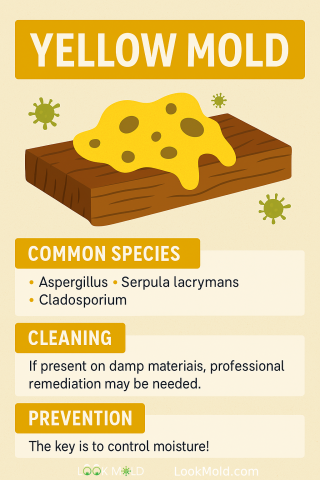Yellow Mold: What It Is, Why It Grows
Expert insight by: Brad Fishbein, Licensed Mold Assessor
Updated April 6, 2025
When most people think of mold, they picture something dark — black streaks in the bathroom or green fuzz on old food. But yellow mold? That one throws people off — and I can’t count how many times I’ve seen it blooming on wet drywall during inspections.
So let’s clear it up: yellow mold is real, it’s common, and in some cases, it can mean trouble. Whether it’s harmless pollen or something like Aspergillus growing on your drywall, the key is knowing what you're looking at — and what to do about it.
Let’s break it down — no scare tactics, just facts from someone who sees this stuff in the field every day.

🧬 What Is Yellow Mold?
"Yellow mold" isn’t one species — it’s just a color that some molds take on when growing in moist, shaded spots. Some are fungi, others are slime molds, but either way, if it’s showing up indoors, it’s worth your attention.
What You Might See in Real Life:
- Yellow fuzz along baseboards or the edge of a bathroom wall
- Streaks of yellow growing on water-damaged drywall or ceiling tiles
- Yellow film or powder that looks like pollen collecting on windowsills
If you’ve got moisture problems and something yellow’s spreading? You’re not crazy — and it might not just be seasonal dust. HUD confirms mold loves damp corners and tight air circulation. Bathrooms, closets, and crawlspaces? Prime real estate for mold.
🧫 What Type of Mold Could It Be?
Not all yellow mold is the same. Some are relatively harmless — others, not so much. Here are the ones I see most often:
🟡 Aspergillus
Super common, especially after water damage. It loves drywall and insulation. Yellow strains can sometimes produce mycotoxins — so don’t let it slide.
🟡 Serpula lacrymans (aka the "Home Eater")
This one targets wood and causes dry rot. You usually won’t see it in living spaces unless it’s eaten through from behind a wall or floor. Yellow and crumbly? That’s your sign.
🟡 Cladosporium
Normally dark green or black, but sometimes yellowish. Shows up in dusty, damp corners — window sills, air vents, tile grout. Not the most toxic, but still not something you want spreading.
Doesn’t matter what color it is — if it’s growing indoors, it needs to go.
🏚️ Can Yellow Mold Damage Your Home?
Definitely. Especially if it’s been sitting around undisturbed. Serpula lacrymans, for example, feeds on wood and can chew right through framing if left alone.
Check yellow mold near:
- Floor joists
- Roof decking
- Around windows and door frames
It could be your first sign of a much bigger moisture issue.
🏠 Where Does Yellow Mold Grow Indoors?
Here’s where I find it most during inspections:
- Behind baseboards and crown molding
- On drywall that’s been wet more than a day
- Under sinks (especially in older cabinets)
- Around drafty windows
- Inside HVAC systems or around drain pans
- In attics with poor airflow or roof leaks
If it’s warm, damp, and still — mold’s probably interested.
⚠️ Is Yellow Mold Harmful to Your Health?
Sometimes. Not all yellow mold is toxic, but some — like Aspergillus — can cause problems, especially for people with allergies or asthma.
Symptoms I’ve seen linked to mold exposure:
- Sneezing, itchy eyes, runny nose
- Fatigue or brain fog
- Asthma flare-ups or tight chest
- Skin irritation
EPA says people with respiratory issues or weakened immune systems are most at risk. If symptoms go away when you leave the house? That’s a clue.
🧪 Yellow Mold or Just Pollen?
Happens more than you think — someone finds yellow dust, assumes it’s mold, and it turns out to be pollen. Pollen’s especially common near windows in spring.
Healthline says pollen is a harmless yellow powder released by trees and plants. But when it settles inside, it looks just like surface mold.
If you’re unsure? Don’t guess. Get it tested.
🧼 How to Clean Yellow Mold Safely
Not every mold problem needs a full hazmat team. But some do. Here’s how to know the difference:
✅ Clean It Yourself If:
- It’s just yellow dust that wipes away (probably pollen)
- You see it on hard, sealed surfaces like tile or plastic
Use soap, water, and a microfiber cloth. Wear gloves and a mask if you're sensitive.
🚫 Call a Pro If:
- It’s on drywall, subflooring, or insulation
- There’s wood rot or softness
- It covers more than 10 square feet
- It’s spreading from HVAC or hidden walls
EPA recommends bringing in pros for large jobs, HVAC involvement, or anything hidden behind surfaces.
🛠️ Bonus Tip: If yellow mold’s eating into structural wood? Don’t rip it out yourself. Call a mold pro and a structural engineer.
🛡️ How to Prevent Yellow Mold from Coming Back
You can’t keep spores out of your house — they’re everywhere. But you can stop them from turning into a problem.
The secret? Moisture control.
- Fix leaks fast — even the little ones
- Use fans after showers and when cooking
- Keep humidity below 50% (a $30 hygrometer can help)
- Dry wet items within 24–48 hours
- Seal up drafty windows and insulate pipes
HUD and EPA both say controlling moisture is the best defense against mold.
🧠 Final Thoughts
Yellow mold might not be black mold — but that doesn’t mean it’s harmless. It’s often a sign of hidden moisture, and if it’s growing, it means something’s not drying properly.
If it’s just dust? Wipe it down. If it’s spreading, fuzzy, or smells musty? Time to get it checked.
Mold isn’t the enemy. Moisture is.
Want peace of mind? Schedule a mold inspection with a licensed pro who knows what to look for.
Sources:
HUD - Mold in Housing
EPA - Mold Cleanup Guidelines
Healthline - Pollen Allergy Info
Wikipedia - Slime Mold
Explore Related Topics:

Meet the author: Brad Fishbein is an ACAC council-certified Microbial Investigator. In the fall of 2012, he became a Licensed Mold Assessor in the State of Florida through the Department of Business & Professional Regulation. Brad has helped homeowners with over 5,000 successfully completed Mold Inspections since 2009.

